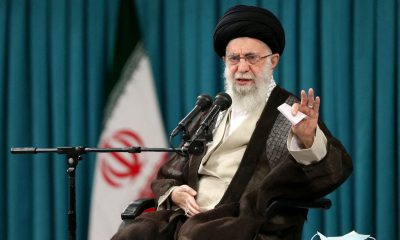News
With Assad Gone, Israel Captures Syria Buffer Zone, Ends Border Agreement
Israel sends ground forces beyond demilitarized zone on border with Syria, marking 1st Israeli entry into Syrian territory since 1973

With Syrian President Bashar al-Assad toppled, Israel sent its ground forces beyond the demilitarized zone on the Syria-Israel border, marking the first Israeli entry into Syrian territory since the 1973 Middle East War.
Assad fled Syria to Russia after anti-regime groups took control of the capital Damascus early Sunday, marking the collapse of the Baath Party regime, which had been in power in Syria since 1963.
It came over a week after anti-regime groups seized control of Aleppo, a major city in northern Syria.
Following Assad’s ouster, the Israeli army conducted dozens of airstrikes against what it called weapons depots in Syria to prevent armed groups from seizing them.
It also sent troops beyond a demilitarized zone in the occupied Syrian Golan Heights and announced the collapse of the 1974 disengagement agreement with Syria.
Buffer zone
On Sunday, the Israeli army said it seized control of a demilitarized zone in the Golan Heights after anti-regime groups took over Syria.
Israeli forces took control of the mountain summit of Mount Hermon on the Syrian side of the border, and several other locations.
The army argued that the move aimed to establish what it called defensive positions in the area to prevent infiltration of armed groups.
The troop deployment marks a significant shift in policy as the first overt entry of Israeli army forces into Syrian territory since the 1974 disengagement agreement that officially ended the last war between Israel and Syria in 1973.
Disengagement agreement
Israeli Prime Minister Benjamin Netanyahu also announced the collapse of a UN-monitored disengagement agreement, which established a buffer zone between Israel and Syria after Syrian troops withdrew from the area following Assad’s ouster.
Signed on May 31, 1974, the agreement stipulates Israel’s withdrawal from all of the areas of Mount Hermon it had occupied during the 1973 War as well as an area of about 25 square kilometers (9.6 square miles) that included Quneitra and other locations.
The agreement defines the current border between Israel and Syria along with the accompanying military arrangements, creating two separation lines — Israeli (blue) and Syrian (red) — with a buffer zone between them.
The agreement is monitored by the United Nations Disengagement Observer Force (UNDOF), as it is tasked with maintaining the cease-fire between Israel and Syria following the October 1973 war.
Since 1974, UNDOF has patrolled the buffer zone between the Israeli- and Syrian-controlled zones.
Israel occupied most of the Golan Heights during the 1967 Middle East war and later annexed the territory in a move never recognized by the international community.
Closed military zones
The Israeli army also imposed closed military zones in the occupied Golan Heights.
Military spokesman Avichay Adraee said the decision was taken based on a security assessment conducted by the army’s Northern Command.
The army also warned residents of five villages in southern Syria close to Israel’s border to remain in their homes amid its military actions in the area.
The targeted villages include Ofaniya, Quneitra, al-Hamidiyah, Samdaniya al-Gharbiyya and al-Qahtaniyah.
Airstrikes inside Syria
The Israeli army carried out dozens of airstrikes across Syria targeting around 100 sites following the fall of the Assad regime.
Israeli media said that the airstrikes targeted military bases, air defense stations and intelligence headquarters as well as long- and short-range missile depots, weapons production centers and unconventional weapon stockpiles.
According to information obtained by Anadolu from opposition-affiliated air monitoring officials, Israeli warplanes hit Damascus’ Mezzeh Military Airport, Quneitra Gara, Minket al-Hadab, Damascus Security Zone, Quneitra Tel al-Sham, Damascus Military Science Center, Tel Aqrabeh in the countryside of Daraa, Kalkaleh Military Base, Tel al-Talib in Daraa, and various sites in the town of Ghita.
Over the past few days, the Israeli military also targeted locations in southern Syria, from Daraa to the capital Damascus and Masyaf in the north.
The airstrikes were meant to reduce the Syrian army’s military capacity, Israeli Channel 12 said.
Kenya Insights allows guest blogging, if you want to be published on Kenya’s most authoritative and accurate blog, have an expose, news TIPS, story angles, human interest stories, drop us an email on [email protected] or via Telegram
-

 Business6 days ago
Business6 days agoKakuzi Investors Face Massive Loss as Land Commission Drops Bombshell Order to Surrender Quarter of Productive Estate
-

 Investigations1 week ago
Investigations1 week agoINSIDER LEAK REVEALS ROT AT KWS TOP EXECUTIVES
-

 Investigations5 days ago
Investigations5 days agoCNN Reveals Massive Killings, Secret Graves In Tanzania and Coverup By the Govt
-

 Business7 days ago
Business7 days agoBANKS BETRAYAL: How Equity Bank Allegedly Helped Thieves Loot Sh10 Million From Family’s Savings in Lightning Fast Court Scam
-

 News1 week ago
News1 week agoEXPOSED: How Tycoon Munga, State Officials, Chinese Firm Stalled A Sh3.9 Trillion Coal Treasure In Kitui
-

 News1 week ago
News1 week agoEx-Boyfriend Withdraws Explosive Petition to Remove DPP After Criminal Case Against Capital FM Boss Resurfaces
-

 Politics6 days ago
Politics6 days agoI Had Warned Raila Of Possible Fallout In The Odinga Family After His Death, Oburu Says
-

 Business16 hours ago
Business16 hours agoConstruction Of Stalled Yaya Center Block Resumes After More Than 3 Decades and The Concrete Story Behind It































